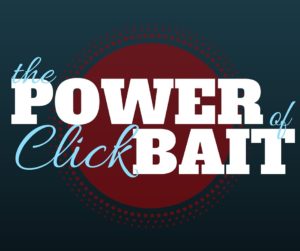For those who are not entirely sure what Clickbait is, here is a master definition devised from a compilation of definitions from Oxford Dictionaries, The Atlantic, and Native Advertising:
Clickbait is an eye-catching link, headline, or phrase that provokes a user to click through to the webpage and read further. This “bait†encourages a user to dive further into a web page and stay on that page longer. For example, Headlines like Cute Baby Elephant Sees the Ocean for the First Time, 30 Things We Still Ask Our Moms, and Soldier’s Homecoming Video, all entice viewer clicks.
The main idea behind clickbait is to increase the curiosity of the user, making the user feel the need to click the link and appease that curiosity. When researching clickbait, there are two realms of thought.
- If the bait entices a user to click, the link is considered clickbait.
- If the user clicks on the bait and is then disappointed by the content provided then it is considered clickbait.
For marketing purposes, let’s use the ideology of the first option. Baiting a reader to click is not necessarily horrible and dishonest behavior as long as it is followed by pretty impressive content.
How Can Clickbait Help My Website?
With any web page, it is important to continually create fresh content. This constant flow of content increases the chances of being ranked higher in a search engine. One of the best ways to initialize the production of this new content is creating a blog page on your website. Getting users to actually interact with your blog is where the clickbait aspect sets into motion. With a dedicated blog, there are 3 main goals for each post, readability, relatability, and shareability.
-
Readability
When creating web content, remember that viewers are not attracted to mundane content. Â The point of clickbait is to ignite curiosity in a reader. When writing blog posts, create a title that is attractive and provokes the coveted click. Having a sensational title is only the tip of the iceberg. Once the eye-catching headline is created the content has to be equally enjoyable and RELATED to the headline of your choosing. One of the main problems with past clickbait titles is when a firm uses a provocative title that leads to an uninteresting article similar to those about the miracle weight loss drug.
-
Relatability
All aspects of the post need to relate to each other and relate to the firm’s mission or products. Misused clickbait can ruin a reader’s trust as well as ruin the reputation of your website, product, and/or brand. Not only does the content have to produce what the title promises, but it also needs to relate with the viewer. Having content that viewer can use or connect with is internet gold. When a viewer can correlate the information given to an element in their own life, the viewer will be more likely to share the content.
-
Shareability
Shareability may be one of the most important aspects of clickbait headlines and posts. For most sites like BuzzFeed, using click bait is a way to increase impressions and guide views to a specific web page. A viewer is most likely going to share content they know other people will also relate with. Increasing the amount of sharing on any social media platform increases the range and networks of people that see your ad, story, blog, etc.
Main Take-Aways
- Depending on the definition, clickbait can be considered a good thing or a bad thing. But, there are benefits when using clickbait to your advantage.
- Spark the curiosity in your reader, and keep them on your page longer.
- Any post should be readable, relatable, and shareable for a reader.
- Enhancing the reader’s experience is the name of the game, the best marketing content is when it flows naturally with regular blog content.
And, most importantly, use clickbait responsibly!

